Camping is a thrilling outdoor activity, but consumers need a comfortable mattress to make the most of the experience. Luckily, the market offers many camping mattresses with varying thicknesses, sizes, and materials, but these choices can make it tricky for businesses to find the perfect option for their consumers.
This article will narrow that list to four trendy camping and hiking mattresses that businesses can’t afford to miss in 2023.
Table of Contents
How big is the market for camping and hiking mattresses
Four camping and hiking mattresses to stock in 2023
Important things to note when purchasing camping and hiking mattresses
Final words
How big is the market for camping and hiking mattresses
Outdoor activities experienced a boom in 2022, and that energy has carried over to 2023. As a result, activities like camping are surging with demand from potential customers ready to get everything they need for a fantastic trip—-and camping mattresses are part of the rush.
Camping mattresses are a segment of the camping equipment market which hit US$ 77.94 billion in 2022. Currently, the market is worth US$ 83.58 billion, but experts predict it will grow to US$ 133.05 by the end of 2023 at a 6.9% compound annual growth rate (CAGR).
Air camping mattresses are the most profitable type in 2023. They’re poised to grow from US$ 844.48 million to US$ 1.477 billion by 2028 at a 7.18% CAGR.
Four camping and hiking mattresses to stock in 2023
Closed-foam camping mattresses
Anyone who has seen the light blue foam pads that are simple to roll up for travel and unroll to make a bed should know this camping bed trend. The blue mattresses are what manufacturers call closed-foam mattresses. Currently, they are the simplest backpacking mattresses for camping.
Manufacturers make them from dense foams filled with small closed-air cells. For this reason, closed-foam mattresses are usually lightweight but may not be very comfortable due to their thinness. However, they’re ideal for camping on relatively flat terrain where consumers don’t need thick mattresses.
Newer closed-foam mattresses may have ridges and come in colors different from the original blue. They also vary in thickness, with some offering added insulation for camping in colder conditions.
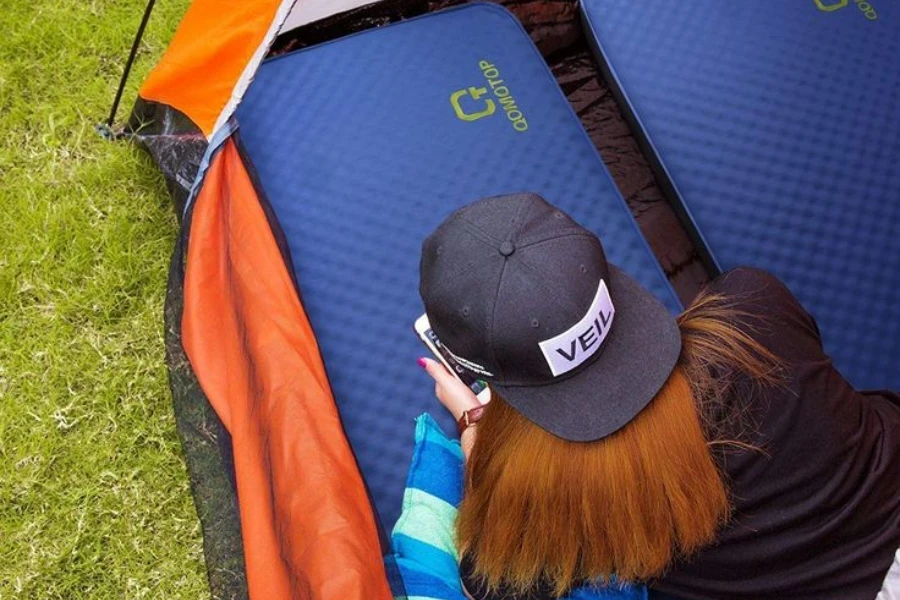
In addition, closed-foam cells can roll up or fold in a Z-shape. But they’re often rigid and can be a bit bulky—-hence, these mattresses may not be ideal for consumers with limited space.
According to Google Ads, these mattresses have three keywords with considerable performance. The most popular one, “closed foam sleeping pad,” had 1000 searches in September 2023, from 880 searches in May 2023 with an increase of 8%.
“Closed cell foam mattress” attracted 590 searches in September 2023, a 9% increase from 480 searches in June.
Lastly, “closed cell sleeping pad” got 480 average monthly searches in September 2023, after experiencing an 8% increase from the beginning of the year with 390 searches.
Air camping mattresses
These mattresses are usually pricier because of the materials and technologies involved in making them. However, they’re lightweight and compact enough for consumers to pack into their backpack storage.
Typically, manufacturers make air mattresses for three-season use (they are not ideal for extremely cold conditions), but some come with insulation or reflective layers to provide extra warmth. In fact, businesses may actually find more options for winter camping mattresses under this trend—compared to other products.
Consumers who prefer thick mattresses for a comfortable night’s sleep will love these sleeping bags. They offer various options with different thickness levels, allowing consumers to pick air mattresses that suit their preferences.
For instance, businesses can offer air mattresses that inflate up to three inches thick while remaining compact for easy backpacking. This is one of the reasons why these mattresses are popular among backpackers, whether they like traveling or not.
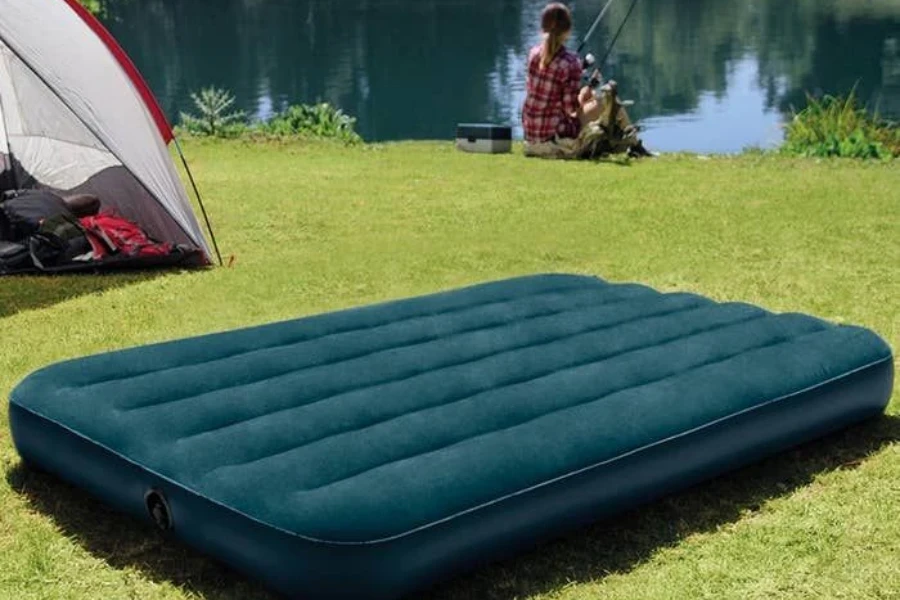
While uncommon, some air mattresses can be inflated by mouth. However, such air mattresses can easily trap moisture, potentially affecting their performance and leading to mold growth in warmer conditions.
Despite being pricier, air mattresses with in-built pumps are the better option. They prevent any moisture from getting trapped inside and are easier to inflate. Consumers can purchase them separately even if the mattresses don’t have in-built pumps.
As mentioned earlier, air camping mattresses are the most popular types on the market today.
Based on Google Ads data, their highest performing keyword (air mattress air bed) got an average of 301000 monthly searches in September 2023, a 9% increase from 201000 searches in the last 7 months—that is, since March 2023.
Self-inflating camping mattresses

These mattresses are a solid choice for campers seeking durability and stronger fabrics. They’re typically cheaper than air mattresses but cost more than closed-foam ones.
Manufacturers craft self-inflating mattresses from air and open-cell foam, making them versatile for various camping styles. They also come in different sizes, offering varying widths and thickness options to help consumers find the perfect one for a comfy night’s sleep.
The best part is that self-inflating mattresses offer fantastic insulation. And, like air mattresses, consumers can easily adjust their firmness by releasing or adding air.
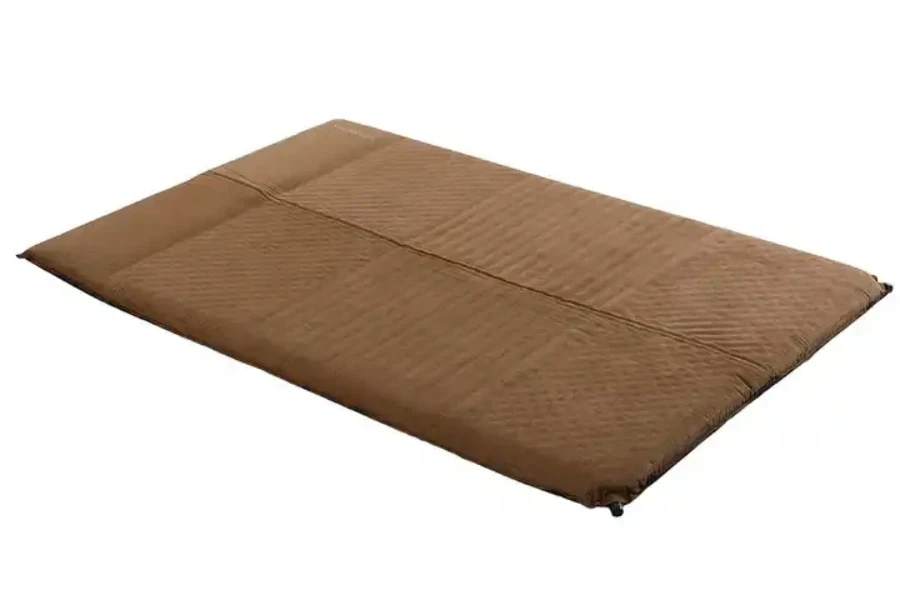
However, these mattresses have two major drawbacks. First, they tend to be heavier than basic closed-foam mattresses. Second, they’re less compact than an air mattress.
Nevertheless, self-inflating camping mattresses are more popular than closed-foam mattresses. Google Ads data reveals that “self-inflating mattress” commands an impressive 33100 average monthly searches in September 2023, while in March 2023, the keyword only had 18100 queries, showing a 12% increase in the number of people searching for it.
Camping cots
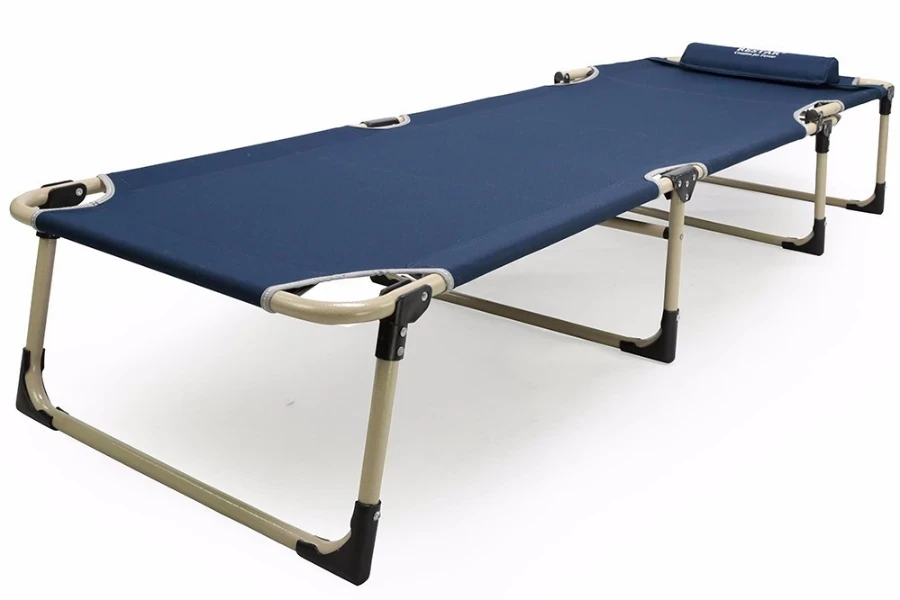
Camping cots have a long history, dating back to the early days of tent camping. They’re like no-frills beds, replacing traditional mattresses with a steel or aluminum frame and a canvas or polyester pad.
However, camping cots are notably larger and heavier than sleeping pads. Their robust steel frames can weigh 20 pounds or more, while aluminum variants may weigh around 15 pounds. Naturally, such weight is impractical for deep woods adventures or backpacking trips.
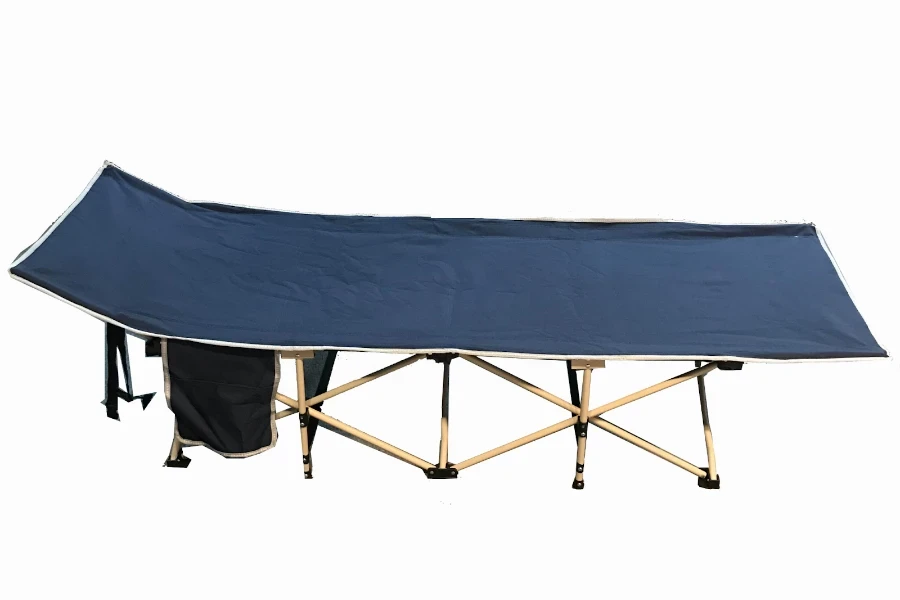
While most camping cots have collapsible designs, some only fold like a camping chair or collapse once. In either case, consumers will still have bulky gear to deal with.
Sleeping cots elevate consumers from the firm ground, providing a comfortable and supportive surface. Many variants come with padding or include a built-in pillion for extra comfort.
According to Google Ads, camping cots average 60500 monthly searchers. But that increased by 12% in August 2023, reaching a whopping 90500 inquiries from 40500 in January 2023.
Important things to note when purchasing camping and hiking mattresses
Consider the R-value
Mattresses with a higher R-value offer better insulation and warmth, making them a key consideration for winter camping. Although some beds have a down insulation layer specifically designed for extremely cold conditions, they may not be available from all manufacturers.
Since some insulation is necessary to prevent campers from feeling cold, most mattresses will include a synthetic insulation layer—even for summer camping. In this regard, businesses must consider beds with an R-value of 4 or higher.
Summer mattresses should have an R-value of 3 or more, which is the perfect range to keep consumers warm at night without making them too hot.
Check the length and width
Sleeping mattresses come in various lengths and widths. Shorter consumers will be likely to choose shorter length options while taller campers will feel comfortable with longer ones.
Consumers don’t want their feet to hang off at the end. So, businesses must check the product description for the mattress length, ensuring it fits their target consumer’s height.
Here’s a table showing the different camping bed lengths and who they’re perfect for.
| Camping bed length | Ideal consumers |
| 60 inches | Perfect for children or adults under 5’6” tall. |
| 72 inches | Perfect for most adults. |
| 75 inches | Perfect for adults over 6” tall. |
| 78 inches | Perfect for adults over 6’2” tall. |
| 80 inches | Perfect for adults over 6’4” tall. |
| 84 inches | Perfect for adults over 6’6″ tall or couples wanting to sleep together on a camping bed. |
Width matters too. Consumers won’t be happy if their arms fall out of the mattress while lying on their bed. Hence, businesses must also check for the mattress’ width to avoid offering something too narrow for their target consumers.
Here’s a table showcasing the different camping bed widths and who they’re perfect for.
| Camping bed width | Ideal consumers |
| 24 inches | Perfect for children. |
| 28 inches | Best for adults who sleep on their side (under 5”6” tall). |
| 32 inches | Best for adults who sleep on their back {5’6” to 6” tall). |
| 36 inches | Best for adults who sleep on their stomachs (over 6″tall). |
| 40 inches | Best for couples who want to share a camping bed. |
| 44 inches | Perfect for couples looking for extra space on their camping bed. |
How does it inflate and deflate?
Having a mattress that’s easy to inflate and deflate is essential. After hours of hiking at high elevations, exerting extra energy to inflate mattresses can be tiring and potentially risky for consumers.
The good news is that most mattresses come with built-in pumps for easy and convenient inflation. Consumers can set up their tent, unroll the mattress, and easily use one hand or foot.
Quick deflation is also vital. If the mattress takes too long to deflate, requiring consumers to roll and unroll repeatedly, it’ll eat into their travel time.
Don’t overlook the weight and packed size
This factor is crucial for consumers with weight and size restrictions. Packing a mattress small enough to fit in their backpack alongside other gear is best.
Thankfully, product descriptions include mattress measurements, including weight. If consumers are on a budget, businesses can consider tapered mattresses—they can reduce size and weight without costing a fortune.
Final words
Sleeping well is crucial during any camping trip, and the right camping mattress can make that happen. However, not all mattresses are universally comfortable, so businesses may not find the perfect one for their consumers immediately.
If tapered mattresses don’t sit right with consumers, there are many other excellent mattress options in various shapes and styles. Close-foam, air, self-inflating, and camping cots are some of today’s best camping mattresses.





 বাংলা
বাংলা Nederlands
Nederlands English
English Français
Français Deutsch
Deutsch हिन्दी
हिन्दी Bahasa Indonesia
Bahasa Indonesia Italiano
Italiano 日本語
日本語 한국어
한국어 Bahasa Melayu
Bahasa Melayu മലയാളം
മലയാളം پښتو
پښتو فارسی
فارسی Polski
Polski Português
Português Русский
Русский Español
Español Kiswahili
Kiswahili ไทย
ไทย Türkçe
Türkçe اردو
اردو Tiếng Việt
Tiếng Việt isiXhosa
isiXhosa Zulu
Zulu